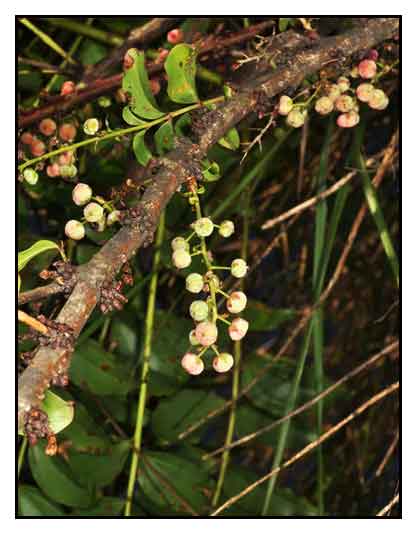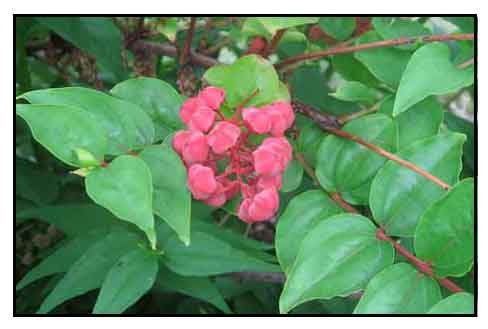 Gen info Gen info
- Closely allied to Coriaria japonica.
- Coriaria is the only genus under the family Coriariaceae.
Botany
Baket is a shrub that grows from 1 to 3 meters high. Young branches are four-angled, reddish or pinkish. Leaves are ovate or ovate-lanceolate, 4 to 8.5 centimeters in length, 2 to 4 centimeters in width, blunt or rounded at the base and pointed at the tip. Flowers are small, about 2 millimeters long, greenish to reddish, borne on simple racemes 6 to 15 centimeters long. Fruit is composed of five very small cocci surrounded by fleshy, persistent petals and sepals of a bluish-black color, giving it a berrylike appearance.
Distribution
- Found in ravines, at an altitude of 1,400 to 2000 meters in Bontoc, Lepanto and Benguet in the Mountain Province.
- Also reported in Taiwan.
Constituents
- Poisonous glucoside isolated from the leaves and fruit.
-
Study yields coriamyrtin 0.176 % in the fruit, 0.009% in the leaves and 0.041 % in the stems.
- Coriamyrtin is the same toxin found in high concentration in the berries of Coriaria myrtifolia, recognized as one of the most neurotoxic plants in the western Mediterranean area.
- Study yielded phytosterols, ellagic acid 3,3'-dimethyl ether, coriamyrtin, b-tutin, naringenin, ursolic acid and a new triterpenoic acid, 20-epibryonolic acid. (4)
- Seeds of C. japonica yielded coriarin, a sesquiterpene lactone, together with tutin, dihydrotutin, and coriarin. (7)
- Study of leaves and roots yielded seven components viz., phytosterol, ellagic acid 3,3’-dimethyl ether, coriamyrtin. β-tutin, narigenin, ursolic acid and 20-epibryonolic acid. (8)
-
Study of roots and fruits yielded corianin, 7-hydroxycoumarin, ursolic acid, coriamyrtin, angustifolin, tutin, quercetin and kaempferol. (8)
- Study evaluated twelve species of Coriaria, the sole genus of Coriaceae, for flavonoid constituents. Major compounds identified were 3-O-monoglycosides of quercetin and kaempferol comprising glucosides, galactosides, arabinosides, xylosides, and rhamnosides. Diglycosdies isolated were the 3-O-rutinosides of both flavonols plus small amounts of 3-O-xylosylglucosides. Naringenin-7-O-ß-D-glucopyranoside was the major constituent of most taxa. The distribution of these compounds was very homogenous among the species tested.
(11)
Properties
- Plant known to be toxic and poisonous.
 Uses Uses
Folkloric
- No reported folkloric medicinal use in the Philippines.
- Igorots reported to be acquainted with the toxicity of the plant.
- In Taiwan, used as folk medicine for gastrointestinal, rheumatism, and uterine cancer.
Others
- Decoction of leaves and fruits known to be deadly poisonous.
- Common in pasture in the Mountain Province, has caused the death of cattle.
- In China, a mixture of crystalline sesquiterpenes, including coriamyrtin and tutin, has been used as muscle injection for the treatment of catatonia; also applied as shock therapy for schizophrenia. (9)
Toxicity
- Coriamytrin: Coriamyrtin which is present in the fruits of C. intermedia (up to almost 0.2%) is a bulbar and medullar stimulant. Symptoms of intoxication include epileptiform convulsions, myosis and dyspnea; a coma might follow, as well as death by respiratory or cardiac arrest. (9) Coriamyrtin is the same toxin found in high concentration in the berries Coriaria myrtifolia, recognized as one of the most neurotoxic plants in the western Mediterranean area - a few berries may induce digestive and neurologic manifestations including seizures, coma and apnea.
- Coriatin: Coriatin, isolated from the fruit juice is considered to be an analog of coriamyrtin.
- Tutin: Several studies have reported tutin as a major neurotoxin in the New Zealand shrubs of the genus Coriaria. Tutin has been isolated from the acetone extracts of achenes from the Coriaria japonica berries.(6)
Studies
• Phytochemicals: (1) Study yielded phytosterols, ellagic acid 3,3'-dimethyl ether, coriamyrtin, b-tutin, naringenin, ursolic acid and a new triterpenoic acid, 20-epibryonolic acid. (2) Further studies of roots and fruits yielded corianin, 7-hydroxycoumarin, ursolic acid, coriamyrtin, tutin, angustiloin, quercetin and kaempferol.
• Toxic Principle / Coriatin: Coriatin, isolated from the fruit juice, was considered to be an analog of coriamyrtin. The relationship between coriatin and coriamyrtin is considered to be analogous to that between picrotin and picrotoxinin. (5)
• Sesquiterpene Lactone / Coriarin: A sesquiterpene lactone, coriarin, was isolated from the achenes (seeds) of Coriaria japonica, along with known constituents tutin, dihydrotutin, and coriarin . (7)
• Antimicrobial / Leaves: In a study of selected plants for antimicrobial activity, against five bacteria viz. Salmonella typhimurium, Bacillus cereus, Escherichia coli, Staphylococcus aureus and Pseudomonas aeruginosa, the leaf extract of C. intermedia was active against all the strains, comparable to the results of four antibiotics (chloramphenicol, vancomycin, kanamycin, and streptomycin). (10)
• 20-Epi-Bryonolic Acid / Antineoplastic / Roots: Study isolated 20-epi-bryonolic acid, a pentacyclic triterpenoid of D.c-friedooleanane-type triterpenoids, from the roots of Coriaria intermedia and stems of Lagenaria siceraria. The compound was found to exhibit antineoplastic activity. (12)
• Bryonolic Acid / Anticancer: Study evaluated the anticancer properties of Bryonilic acid (BrA). a pentacyclic triterpene present in several plants used in African traditional medicine. Study reports BrA inhibits acyl-coA: cholesterol acyl transferase (ACAT) activity in rat liver microsomes in a concentration-dependent manner, blocking the biosynthesis of the cholesterol fatty acid ester tumor promoter. It also demonstrated BrA inhibits ACAT in intact cancer cells with an IC50 of 12.6 ± 2.4 µM. BrA inhibited both clonogenicity and invasiveness of several cancer cell lines. BrA appears more potent than other pentacyclic triterpenes, betulinic acid and ursolic acid. Reversal of inhibitory effect by cholesterol oleate shows that ACAT inhibition is responsible for the anticancer effect of BrA. (13)
Availability
Wild-crafted.
|

![]()




 Uses
Uses 